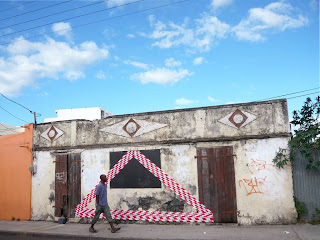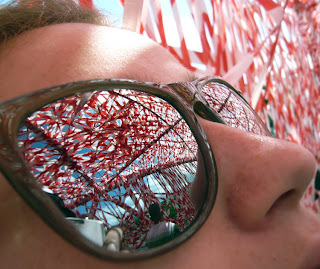Whenever I read the local paper, I always check the obituaries. I don't think it's morbid fascination as much as an old habit. I just want to make sure I know what's going on. Relatively speaking, every day I don't know someone in the obituaries is a good day. Monday wasn't so great. Through Wooster Collective, the last place I'd think to look for death notices, I learned that Lignes Rouges died of a heart attack at the absurdly young age of 27. I interviewed him merely two weeks before his death. He'll never get to see the final product, but I couldn't toss his answers in the trash.
 Near the end of his life, Lignes Rouges worked in Brazil, but his started painting on his native Reunion Island. He began experimenting with graffiti at 14 and continued to mess with the medium when he attended Les Beaux Arts in Paris. "The professors and art historians told me that graffiti was not art and would never be art, like cartoons," he explained. However, Lignes Rouges did not grow discouraged. Transitioning from tags and pieces, he developed a new street style around 2002.
Near the end of his life, Lignes Rouges worked in Brazil, but his started painting on his native Reunion Island. He began experimenting with graffiti at 14 and continued to mess with the medium when he attended Les Beaux Arts in Paris. "The professors and art historians told me that graffiti was not art and would never be art, like cartoons," he explained. However, Lignes Rouges did not grow discouraged. Transitioning from tags and pieces, he developed a new street style around 2002. Lignes Rouges honed his style, using taped lines of red and white that would later become his trademark. "They're the colors that make the most sense in the street," he said. "They're used a lot on street signs, so they have an intimate relationship with the forbidden. The forbidden is the essence of graffiti." Galleries never appealed to Lignes Rouges; he felt they were too confined and not conducive to dreaming. Instead of compromising his ideas, he chose to work in the street alone. "My work doesn't fit well with the styles of others," he admitted.
Lignes Rouges honed his style, using taped lines of red and white that would later become his trademark. "They're the colors that make the most sense in the street," he said. "They're used a lot on street signs, so they have an intimate relationship with the forbidden. The forbidden is the essence of graffiti." Galleries never appealed to Lignes Rouges; he felt they were too confined and not conducive to dreaming. Instead of compromising his ideas, he chose to work in the street alone. "My work doesn't fit well with the styles of others," he admitted. While he traveled extensively, Lignes Rouges placed more emphasis on the piece than the location. "I love working in public spaces where people can see my work without having to jump a wall, walk through mud, or get hassled by bums," he laughed. He cited a rare collaboration on Reunion Island with close friend Kid Kréol as one of his favorite experiences.
While he traveled extensively, Lignes Rouges placed more emphasis on the piece than the location. "I love working in public spaces where people can see my work without having to jump a wall, walk through mud, or get hassled by bums," he laughed. He cited a rare collaboration on Reunion Island with close friend Kid Kréol as one of his favorite experiences. Painting in the streets led to some interesting encounters. He recalled, "I was on the Champs-Élysées when I was arrested by local policemen who didn't understand anything. They threw me in jail. A brigade of national policemen arrived and told the local policemen that it was not their territory so they didn't have the right to arrest me. The local police unlocked the handcuffs and sent me on my way. Long live the police wars!"
Painting in the streets led to some interesting encounters. He recalled, "I was on the Champs-Élysées when I was arrested by local policemen who didn't understand anything. They threw me in jail. A brigade of national policemen arrived and told the local policemen that it was not their territory so they didn't have the right to arrest me. The local police unlocked the handcuffs and sent me on my way. Long live the police wars!" At the time of his death, Lignes Rouges was living and painting in Brazil. He loved traveling to see how cities functioned in harmony with their surroundings. Brazilian culture in particular captured his heart. "I love tropical countries," he gushed, "because their people put their private lives in public places. They set up a canopy and put their televisions in the street like it's their living room. They're not shocked to see an artist work in the street because the street belongs to everyone, not just the building across the street."
At the time of his death, Lignes Rouges was living and painting in Brazil. He loved traveling to see how cities functioned in harmony with their surroundings. Brazilian culture in particular captured his heart. "I love tropical countries," he gushed, "because their people put their private lives in public places. They set up a canopy and put their televisions in the street like it's their living room. They're not shocked to see an artist work in the street because the street belongs to everyone, not just the building across the street."You can still view Lignes Rouges's work on his website. I wish I could go to Brazil myself and see his pieces before they're washed away.
Adieu, L.R., et merci pour toute la beauté que vous avez partagé avec le monde.
haha very funny you saw that in everywhere, very interesting costume, I'm gonna find out why they do that.
ReplyDeleteThanks
Took me time to read all the comments, but I really love the article. It proved to be very helpful to me and I am sure to all the commenters here! It’s always nice when you can not only be informed, but also engaged! I’m sure you had joy writing this article.
ReplyDelete